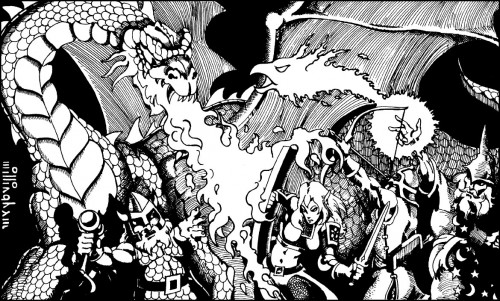Dungeons & Dragons had a lovely feature missing from Advanced Dungeons & Dragons and some of its successors: morale. By this I mean a mechanism by which the Dungeon Master could determine if an antagonist was willing to fight it out to the bitter end or choose the better part of valor. A mechanism transparent to the rest of the players and therefore fostering a general feeling of trust in the DM as a fair arbiter of the rules. The evil henchmen didn’t doggedly stick to it because the DM wanted to whittle down your hit points and force you to expend resources. They did so because their basic stats and the dice said so.
An old copy of the Basic D&D Creature Catalogue says you simply roll two six-sided dice and compare the result to the “morale” stat listed for a given creature. Second Edition used two ten-sided dice and a broader scale. Personally I like to use a twelve-sided die in my Type V campaign. It’s one of the few times that die is used, and my players are learning to associate it with morale checks. If the die roll is greater than the creature’s morale check, it bugs out. When is the check called for? Whenever the narrative seems to justify it. A few times I’m likely to pull out the d12:
- A creature first takes damage (and hadn’t been expecting to)
- A creature is reduced to under half its hit point total
- A creature witnesses an ally fall or flee
- A creature witnesses half its allies fall or flee
- A creature is subjected to explicit intimidation
These are more-or-less in keeping with the rules available from the battered old Red Box of my youth. While this basically works out fine, one big missing factor is a direct translation from the Basic D&D to 5th Edition D&D creatures. We could compile an exhaustive listing of all the newer monsters and their closest Basic Edition analogs, but the return on investment seems out of whack. Instead perhaps we rattle off a few well-known creatures and their morale values as points of reference for winging it. Keep the improvisation of stats to prep-time whenever possible, of course.
- 5 – Herd animal, Rat
- 6 – Kobold
- 7 – Normal dog, Sprite
- 8 – Bandit, Elf, Orc, Small White Dragon
- 9 – Ghost, Goblin, Treant
- 10 – Dwarf, Elemental, Grizzly Bear, Hobgoblin, Troll
- 11 – Archon, Huge Red Dragon War dog
- 12 – Beholder, Berserker, Golem, Skeleton, Zombie
Modifiers can apply, naturally, such as when there is a particularly charismatic or renown leader present, bolstering an adversary’s confidence. Or if a player character just decapitated the same renown or charismatic leader. Common sense, as always, is welcome when adjudicating rules. Doubly so with old rules home-cooked into new systems.
